‘Tav karkamalvare nakhadbhutashringam, dalit Hiranyakashyapu tanubhringam, Keshavadhritharirupa jai Jagdish hare’
(O Krishna! You took the form of a lion-man and with your mountain-like nails you annihilated Hiranyakashyapu. Hail to you the Lord of the World)
-- Jaidev (Sanskrit poet of 12th cen. CE)
Puranas and legends describe Vishnu’s incarnation as Narasimha in picturesque detail. The demon king Hirnyakashyap hated Vishnu so much, for killing his brother, that he decreed that no one should worship Vishnu, but him. Hiranyakashyapu’s own son Prahlada opposed him for he was an ardent devotee of Vishnu and continued praying to him in spite of being subjected to severe torture. To rescue his cherished devotee from his tyrannical father, Narasimha, with a thunderous roar, fire-sparks spewing from his cavernous mouth, burst forth from the pillar, threw Hiranyakashyapu prostrate on his lap and ripped open the demon’s stomach with his bare claws.
In India starting from the era of Kushana and the Guptas religious motifs on coins were used freely. On the lion-trampler type coins of Kumara Gupta the legend reads Saksadiva Narasimho simhamahendro jayatyanisam - roughly it translates to: the lion among men Mahendra is, as it were, Narasimha incarnate. The acclamation of the king compared to God Narasimha is obviously a proud moment in the life of the king. In south India during the Pallava rule wheels of Vishnu were incorporated in coins but only during the time of the Vijayanagara Empire did the Vaishnavite images start appearing. Among them, the portrayal of different incarnations of Vishnu were represented. Narasimha was worshipped for the victory in war. He is one of the few Vishnu incarnations in his fierce form; therefore kings favoured him. They wanted to emulate his bravery and valour and so his coins were minted in profusion.
King Harihara II (1377-1404) of the Vijayanagara empire was the first ruler of the empire who issued coins with the images of divine couples. Among them came Lakshmi-Narasimha too. Most of his descendants followed the pattern. One special feature of these coins is that they have a close resemblance to the temple idols. Vijayanagara-kings were ardent followers of Narasimha and so the figures of the deity found on the coins are similar to those found in the various temples of the era. Other South Indian rulers also followed the pattern.
The Wadiyars of Mysore state were originally subordinates of Vijayanagara rulers but later on started their own dynasty. As far as the issuing of coins are concerned they followed their predecessors. In the state of Mysore, gold fanams were issued under the reign of King Kanthirava Narasaraja (1638-1662). He was the first king of Mysore who issued coins with the inscription on the reverse. These coins are labelled as Kanteerava fanams. Most of these coins, weighing less than 2 gms, bear the image of Narasimha. They measure approximately 6mm diameter. Despite the miniscule size, the artists have rendered superb work. It has a wide range of beautiful countenance. The coins depict Narasimha in yoga mudra with some of the coins are with a stick holding up his legs. The God holds chakra and conch in his upper hands and his normal hands are either resting on his knees or beside it.
Two sides of coins are known as obverse and reverse. In the ancient coins obverse represents the head or bust of the king who has issued the coin hence is the more important side and is called ‘head’ in layman’s terms. The other side of the coin, the reverse or ‘tail’, is normally with figures of deities or symbols.
Kings issued coins in different postures of Narasimha: In his theriomorphic form, Yoga-Narasimha, Lakshmi-Narasimha and Raudra-Narasimha.
Raudra Narasimha:
The Matsya Purana says that as a Raudra Narasimha, his look should be ferocious and his expression should be full of rage and he should appear attacking the demon. According to the Purana the demon symbolizes ignorance and Narasimha is wisdom and knowledge. This form is characterized by bulging eyes and strong sharp teeth, as seen on the coin depictions.
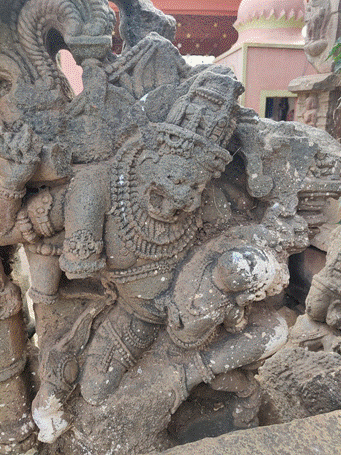
Fig. 1. Ugra Narasimha from Shiva Temple, Narayanpur, Bidar, Karnataka. Courtesy: Wikimedia commons.
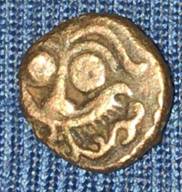
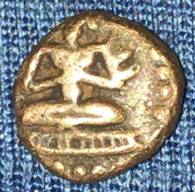
Fig. 2. Gold Coin of Raudra-Narasimha belongs to Nayak Rajas from the 18th century CE. His round bulging eyes, broad open mouth is enough to depict god’s ferocious form. But scholars feel that this is the image of Kirtimukha and not of Narasimha. Courtesy: H. Jain Hemant Kumar Chopra Chennai (through Venkatesh).
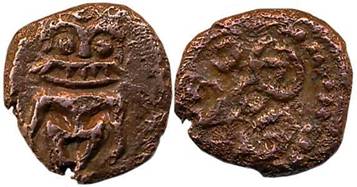
Fig. 3. Copper coin of Raudra-Narasimha. It is from South Central Tamilnadu issued by Nayakas. 18th century. The obverse shows Narasimha standing with a wide-opened mouth looking grotesque. Courtesy: Pukhraj Surana.
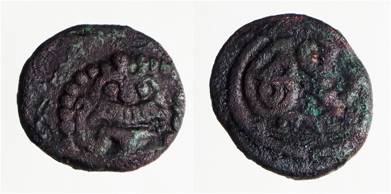
Fig. 4. Copper coin of Raudra-Narasimha, issued by Nayakas of Madurai, belonging to the 18th Century. Narasimha’s mane is depicted as round curls; his eyes are round and bulging. He has a wide ferocious-looking mouth. Courtesy: Gautam Jantakal.
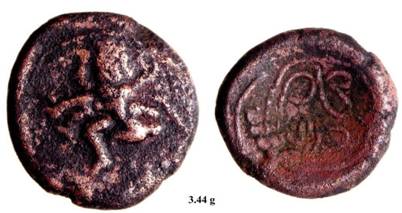
Fig. 5. Raudra Narasimha’s copper coin, from the same period and dynasty, but with different patterns. This one depicts Hirnyakashyapu in God's lap getting ripped apart. Courtesy: Gautam Jantakal.
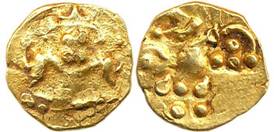
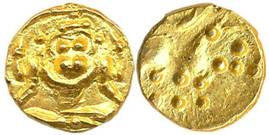
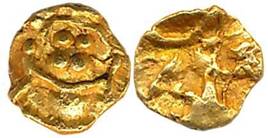
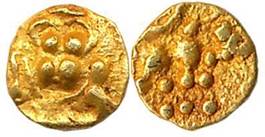
Fig. 6. 12th-13th century gold fanam belonging to Hoysalas shows a lion (Shardul) on the obverse and Narasimha on the reverse. Courtesy: Girish Veera.
Theriomorphic Form:
In the early stage of Narasimha-cult’s development, he is perceived as a lion. He should be shown as a fierce seated lion with his mane falling over his shoulder. Except for this incarnation, almost Vishnu is depicted as a mild God. However, Varaha, his predecessor, and Parsuram are exceptions.but they are no match to Narasimha's violent and ferocious nature. He is represented in aniconic, theriomorphic, or hybrid anthropomorphic form.
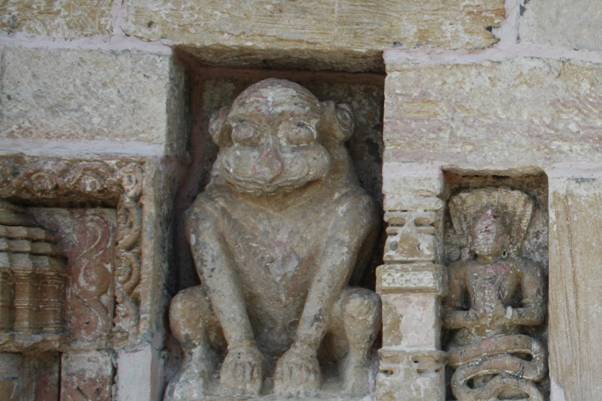
Fig 7. Narasimha in his theriomorphic form. From a temple Bhatala, Chandrapur, Maharashtra. Courtesy: INHCRF Archive.
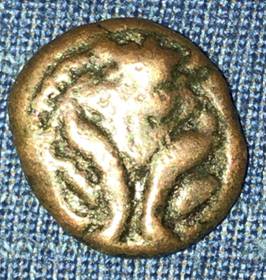
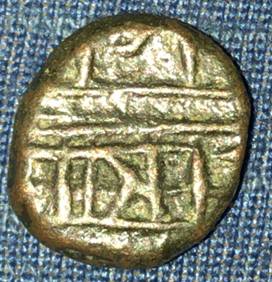
Fig. 8. During the 16th century, Narasimha’s gold and copper coins in his theriomorphic forms were issued by many South Indian Rulers. One such gold coin is issued by Wodeyars which shows seated Narasimha as a lion on the obverse and reverse has corrupt Nagari legend. It belongs to the 17th Century CE. Courtesy: Vankatesh.
Yoga Narasimha:
In the form of Yoga-Narasimha, the deity is depicted seated in padmasana in the utkutika posture, with yoga-patta around his knees. According to Purana Yoga Narsimha’s complexion should be crystal white, but the colour of the garment worn by him should be red.
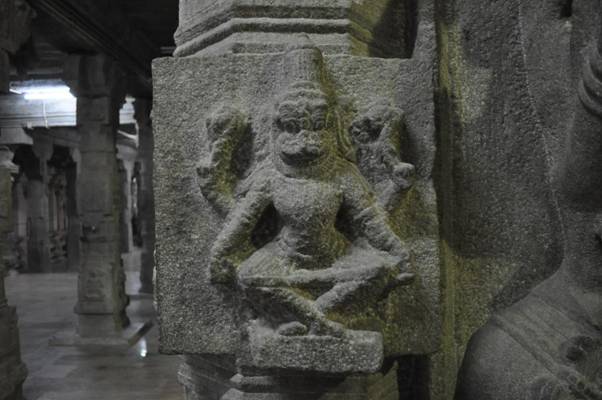
Fig. 9. Yoga Narasimha with yogapatta from Madurai.
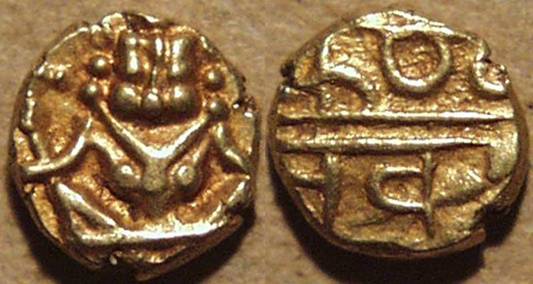
Fig. 10. The gold coin, based on Hampi’s Yoga Narasimha is quite evident by not only the shape of the head and posture but also the yoga-patta around the Narasimha. It was issued by Mysuru king Kanthirava Narsaraja Wodeyar. This gold fanam has Yoga-Narasimha on the obverse and reverse has three lines written in crude Devanagari script: Sri/Kanthi/Rava. Courtesy: Pankaj Tandon.
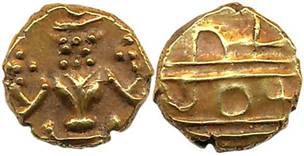
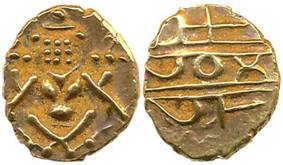
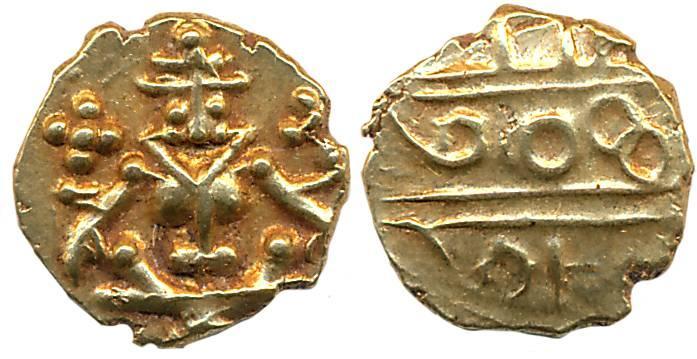
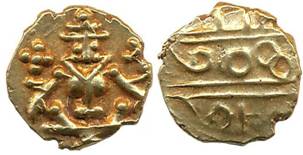
Fig 11. Gold fanams depicts Yoga Narasimha. It was issued by Mysuru king Kanthirava Narsaraja Wodeyar. This gold fanam has Yoga-Narasimha on the obverse and reverse has three lines written in crude Devanagari script: Sri/Kanthi/Rava. Courtesy: Pukhraj Surana.
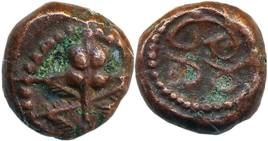


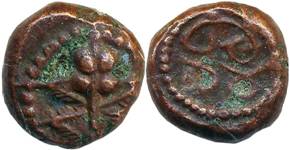
Fig.12. Kasu (copper coin) issued by Madurai Nayakas show Yoga-Narasimha with legend sri Veera in Telugu,18th century. Courtesy: Pukhraj Surana.
Lakshmi-Narasimha
Apart from these types of coins Lakshmi-Narasimha or Devi sahita Narasimha coins were also issued by some dynasties. As the name applies, Narasimha is depicted seated along with his consort. This form can be a measured move to show this wild divinity in a more acceptable, peaceful and domesticated manner. This form when worshipped is supposed to bring wealth and prosperity.
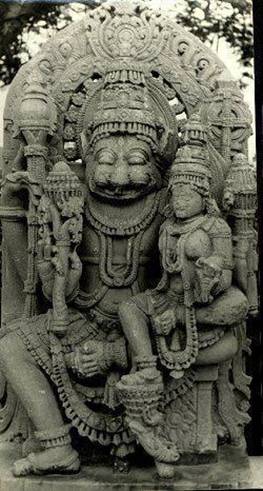
Fig. 13. Lakshmi-Narasimha. Courtesy: Seema Gupta.


Fig. 14. Lakshmi-Narasimha is again from the family of Mysuru Wodeyars. It shows four-handed Narasimha seated with Lakshmi on his left thigh. Issued by Kanthirava Narasaraja Wodiyar this one is half gold Pagoda. On the reverse, It has Nagari legend which reads as Shri Kanthi/Rava Nara/Sa Raja. Courtesy: Pukhraj Surana.
Girija-Narasimha:
At times Narasimha is depicted as seated on the throne. He holds chakra and shankha in his upper two hands and his normal hands are in Abhaya and Varada mudra. He is called Girija because lions roam in forests and mountains.


Fig. 15. Gold coin, from the Nolamba dynasty. Initially, Nolambas were feudatories to Pallavas, Chalukyas of Badami, Gangas and Rashtrakutas. Later on, they also became feudatory of the Chalukyas of Kalyani. Nolambas ruled from 735 to 1052 CE. The coin depicts Obverse: recumbent bull, reverse: Narasimha. Mostly all the coins issued by Nolambas bear humped bulls on the obverse as they were followers of Shiva. The coin bears the legend Shri Nolamba Narayana in early Kannada inscription. Seated Narasimha is four-armed. Courtesy: Pukhraj Surana.

Fig. 16. A gold token depicts four-armed Narasimha holding non-decipherable attributes. He is seated in padmasana. Courtesy: Pukhraj Surana.
To summarize, the South Indian kings - Pallavas, Hoysalas and Wadiars were ardent followers of Narasimha. By minting Narasimha coins in their era, they have shown proof of their devotion. As can be seen, the images of these coins were carved in a different manner; in action, meditation, amorous as well as in fierce and gruesome forms.
